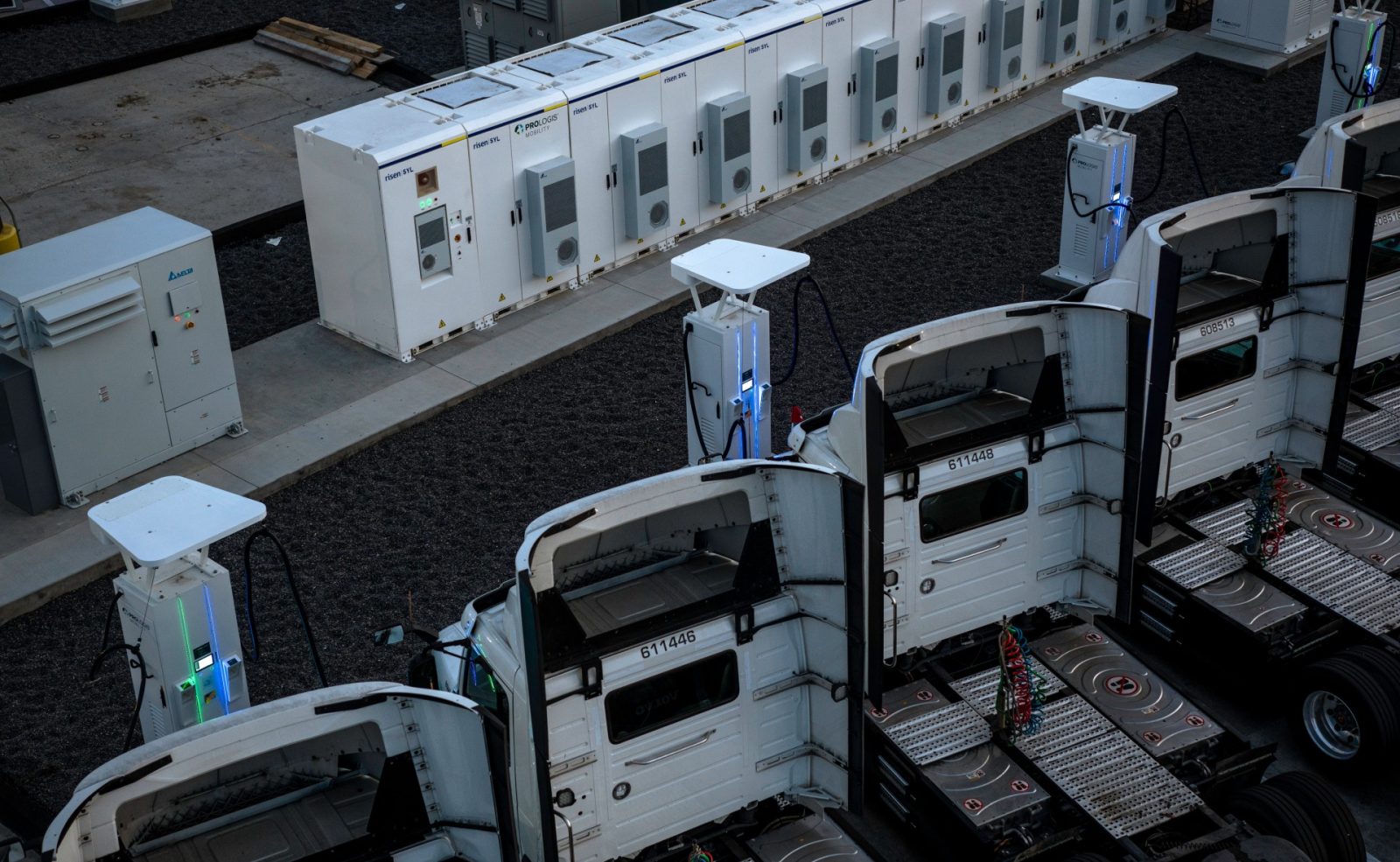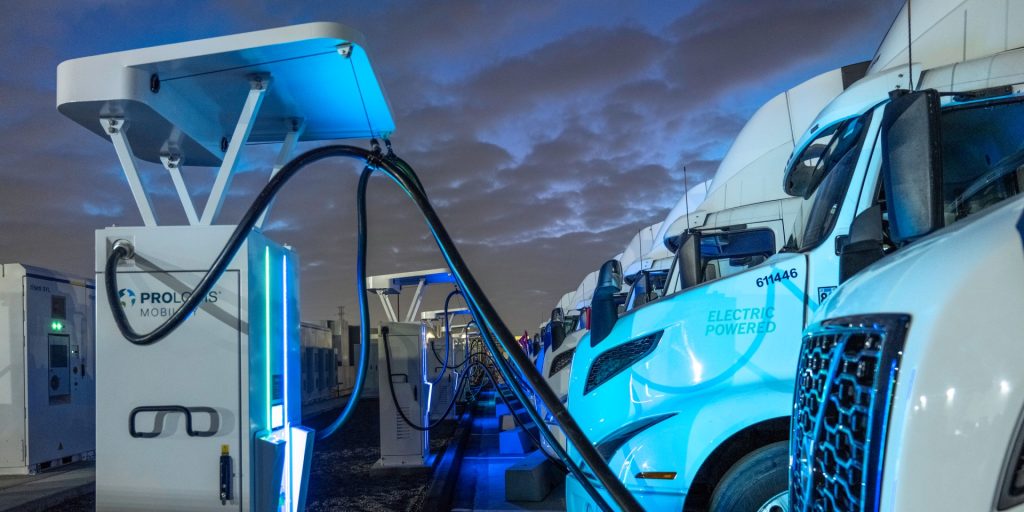
Southern California’s largest heavy-duty electric truck charging depot, powered by the US’s largest electric truck microgrid, is now online and fueled by natural gas.
US’s largest heavy-duty electric truck microgrid
Prologis (NYSE: PLD) and Performance Team, A Maersk Company, have launched the heavy-duty electric truck charging depot near the Ports of Los Angeles and Long Beach.
The Denker Avenue charging depot is off the Harbor (110) Freeway, within five miles of Interstate 405 and California State Route 91 (SR91), and it’s capable of charging up to 96 electric trucks simultaneously.
Heavy-duty EV charging hub developer Prologis and logistics services company Performance Team constructed the charging hub in an impressive five months. The 360 kW chargers are manufactured by Taiwan-headquartered Zerova.
Performance Team will charge its fleet of Volvo VNR Electric trucks there – the e-trucks have a range of 240 miles and can charge up to 80% in 90 minutes. (Performance Team operates more than 140 EVs across the US.)

Charles van der Steene, regional president for Maersk North America, said, “This facility strengthens our ability to offer customers a decarbonized alternative to conventional trucking and brings us closer to our goal of reaching net zero by 2040.”
Citing California’s requirement to end the sale of electric drayage trucks by 2035 and electric heavy-duty trucks by 2045, Prologis and Maersk said they wanted to get electric trucks on the road faster, so they decided to go the microgrid route.
The Prologis Denker microgrid uses 2.75 MW of Mainspring Energy‘s fuel-flexible linear generators paired with 18 MWh of batteries to provide up to 9 MW of charging capacity. The Mainspring Linear Generator is versatile – it can switch between fuels like hydrogen, ammonia, and biogas.
Electrek’s Take
Prologis and Maersk are powering this microgrid, and thus Southern California’s largest heavy-duty electric truck charging depot, with natural gas.
I asked a Prologis spokesperson when they’d the microgrid would be switched to hydrogen, as Prologis made a point of describing the linear generators in its announcement as “hydrogen ready.” They replied, “We don’t have a timeline for hydrogen.”
(And if you’re thinking, “What about solar and storage?” as I did, I asked – it’s because the project doesn’t have enough acreage for the power it needs.)
I won’t get on my high horse about this disappointing discovery buried at the end of the press release. When the public uses DC fast chargers connected to the grid on a road trip, we usually don’t know what’s powering our fast charging stations. However, the US has set a 100% clean electricity goal by 2035, and California already has around 60% low-carbon electricity generation on its grid.
The Denker Avenue charging depot can be switched to sustainable fuels, and getting more heavy-duty electric trucks on the road as quickly as possible is excellent because it reduces transport emissions.
Plus, this microgrid will work if there’s a power outage, which is also a clear advantage over diesel trucks – if the power is out, they can’t charge, either.
I wish that Prologis had been more transparent about why the microgrid will be on natural gas indefinitely and that there was a projected timeline for switching it to hydrogen. Had they committed to that goal, this project would have been a true trailblazer.
Top comment by jerry paul
They don't have a timeline for hydrogen fueled scenario because ..... it doesn't make sense!
The hydrogen would have to be sourced from natural gas or from electrolysis of water from green electricity or electrolysis of water from fossil fueled electricity.
Case 1: hydrogen from natural gas. Here the CH4 molecule is split (using energy) and carbon emitted as CO or CO2, then Hydrogen is compressed and transported to the electric generator (using more energy) and then used in a generator to make electricity for the trucks.
It is less wasteful to just use the natural gas directly in the generator to make the electricity for the trucks. The same CO2 is emitted and less processing energy is wasted. A combined cycle natural gas generator is around 60% efficient while the best fuel cells using hydrogen are also around 60% efficient (without waste heat collection for both) and the natural gas combined cycle powerplant is proven technology.
Case 2: Hydrogen sourced from electrolysis using green electricity. Why not use the green electricity directly to charge the trucks? Saves on hydrogen compression and transport energy and any wasted electrolysis energy.
Case 3: Hydrogen sourced from electrolysis from fossil-fueled electricity. Again, why not use the electricity directly to charge the trucks and save on hydrogen compression and transport energy and any wasted electrolysis energy.
Update: In a follow-up, Prologis sent another response today: “We are currently using natural gas in the short term and working closely with the LA Department of Water and Power to determine when the grid will be ready for us to plug in.”
Read more: Einride partners with Maersk to electrify over one million shipments over the next five years
If you’re an electric vehicle owner, charge up your car at home with rooftop solar panels. To make sure you find a trusted, reliable solar installer near you that offers competitive pricing on solar, check out EnergySage, a free service that makes it easy for you to go solar. They have hundreds of pre-vetted solar installers competing for your business, ensuring you get high quality solutions and save 20-30% compared to going it alone. Plus, it’s free to use and you won’t get sales calls until you select an installer and share your phone number with them.
Your personalized solar quotes are easy to compare online and you’ll get access to unbiased Energy Advisers to help you every step of the way. Get started here. –ad*
FTC: We use income earning auto affiliate links. More.





Comments